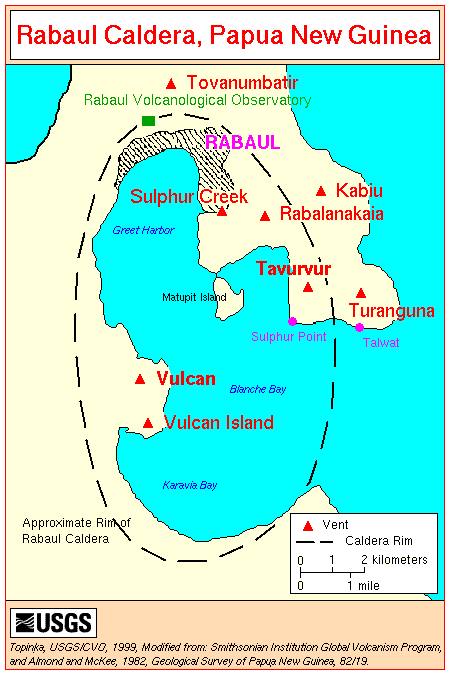 When you move the mouse pointer over the map, unit name, strength and coordinates are displayed as a label. When you press terrain button object name is displayed (city, river, sea, ...) |
Rabaul
PacPG: 3.8.1945 - 31.8.1945
Scenario Map:
|
|
|
Changes and corrections of map:
|
Scenario author: Scenario origin: Last revision date: |
stanny 17.6.2005 9.5.2010 |
First release: Revision released: |
4.8.2009 ( Release 01 ) 4.4.2011 ( Relase 02 ) |
| One of the scenarios, which is not in PacG executable, but the only map is ready for enthusiasts who would like to use it to create the next scenario. This is conquest of the the Japanese base of Rabaul on the island of New Britain. Map had to be completely remade, because as apparent at first glance, was somewhat inaccurate. After adjustments was included as the final battle of the Australian campaign. |
Original map:
|
|
|
Historic overview:
On the island of New Britain in the Bismarck Archipelago had been sent Australian 5th division. In November 1944, when the Australians arrived there, the Americans have mastered the five sixths of this great island. In the remaining part was located about 70,000 Japanese troops, mainly concentrated on the north end, in an area until recently extremely important naval and air base of Rabaul. Commander of 5th Division General A.N. Ramsay wondered pragmatic: moved up to the neck separating the so-called Gazelle Peninsula with the rest of the island of Rabaul, neck tightly dammed and left a strong Japanese garrison to fall slowly into disrepair and decay .... After the war confirmed that the attack on Rabaul would most likely become a bloody and costly paid event, as many hills and heights around Rabaul port were filled with underground and other defensive positions fitted with large stocks of ammunition and explosives. (Miloš Hubáček - Válka končí v Pacifiku II, Paseka 2000)
| |||||||||||||||||||||||||||||||||
Game play matters:
| Campaign play: Final scenario of Australian campaign. |
Scenario data:
|
Map size: 30 x 30 hexes 15 turns, 2 days per turn Version: PacAGPG 2, Starting side: Allies, Campaign: Australian campaign, Order in campaign: 5. |
||||||||
|
||||||||
|
||||||||
|
||||||||
|
||||||||
|
Game time costingness of scenario: 20.73 % (product of units and turns numbers divided by difference between the most long and the most short scenario) |
||||||||
|
Number of Allied units: 44 units, from them are 17 core units and 27 auxiliary units 8 air units, 0 naval units and 36 ground units 0 of units are loaded to air transport and 0 to naval transport |
Transports Air/Naval: Allies - Axis 2/0 - 0/0 |
|||||||
|
Number of Axis units: 84 units 2 air units, 0 naval units and 82 ground units 0 of units are loaded to air transport and 0 to naval transport |
Initial prestige + every turn donation: Allies / Axis 750 + 0 / 270 + 85 |
|||||||
|
Max number of Allied units: 46 units, from them are 16 core units and 30 auxiliary units - on start of scenario is possible to purchase 2 unit (-1 core + 3 auxiliary) |
||||||||
|
Max number of Axis units: 85 units - on start of scenario is possible to purchase 1 units |
||||||||
Transport units:
|
||||||||
|
| Allied units: ANZAC HW 44 (Australia & New Zealand) Flamethrower Infantry (Australia & New Zealand) ANZAC 1943 (Australia & New Zealand) Bridge Engineers (Australia & New Zealand) AC III Sentinel (Australia & New Zealand) Matilda II (Australia & New Zealand) 6 Pdr ATG (Australia & New Zealand) 25 Pdr Gun (Australia & New Zealand) GB 6´´ Gun (Australia & New Zealand) 15 Pdr Gun (Australia & New Zealand) 20mm SPAA (Australia & New Zealand) 20mm AD (Australia & New Zealand) CA-15 Kangaroo (Australia & New Zealand) CA-8 Wirraway (Australia & New Zealand) Mosqito MkVI (Australia & New Zealand) Vengeance MkI (Australia & New Zealand) Hudson MkIII (Australia & New Zealand) Wellington (Australia & New Zealand) GB 3 Ton Lorry (Australia & New Zealand) |
Axis units: Kyoka Hohei 1943 (Infantry HW 1943) (Japan) Hohei 1943 (Infantry 1943) (Japan) Shinhoto Chi-Ha (Japan) Type 97 Chi-Ha (Japan) Type 97 Te-Ke (Japan) Type 1 47mm (Japan) Type 94 37mm (Japan) Type 1 Ho-Ni 2 (Japan) Type 96 150mm (Japan) Type 38 120mm (Japan) Type 91 105mm (Japan) Meiji 38 Improved 75mm Field Gun (Japan) Type 99 88mm (Japan) Type 98 20mm (Japan) Type 14 105mm (Japan) Type 88 75mm (Japan) 5´´ Coastal Battery (Japan) 3´´ Coastal Battery (Japan) Bunker (Japan) Strong Point (Japan) Pill Box (Japan) A6M3 Hamp (Reisen) (Japan) A6M2 Zero (Reisen) (Japan) |
The same time period scenarios:
| Manchuria 1945 (PacAGPG 2), Hokkaido (PacAGPG 2), Sakhalin (PacAGPG 2), Shumshu (PacAGPG 2), Manchuria 1945 (PacPG 1) |
| Airfield Bismarck Sea Blanche Bay Greet Harbor Lakunai Aerodrome Matupit Island Mount Kabiu Nonga Rabalanakaia Rabaul Display all mapnames in list... |
Tactical map (large & detail):

|
|
|
|
Basic map |
|
|
Map with unloaded transports and order numbers of units |
Battlefield map:


|
|